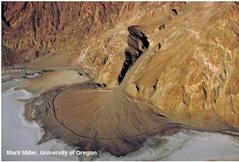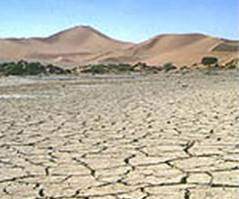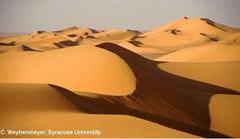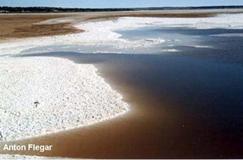Hot Deserts
We often think of deserts as endless miles of sand dunes – yet dunes cover only 1/5th of the Sahara! There are large areas of bare rock, and oases where water can be found. It may only rain once in ten years or more, but a single storm can transport more sediment in a sudden flash flood than is moved by wind during the many years in between such storms.
Desert deposits often have a red colour due to oxidation of iron compounds in the sediments.
Desert deposits often have a red colour due to oxidation of iron compounds in the sediments.

Alluvial fan, Death Valley

Photo courtesy of Nigel Mountney, Earth Sciences, Keele University

Fine dust may be carried much longer distances, often hundreds of miles.
Water-lain deposits
Water-lain deposits are made up of material washed down canyons into low-lying areas after sudden storms. As these fast-flowing rivers of mud, sand, and boulders slow down, they rapidly deposit material to form alluvial fans.
Water carries finer silt and mud further onto the lowland areas, where it settles out in temporary lakes called playas.
As the water evaporates, dissolved mineral salts are left behind to form salt pans.
Water carries finer silt and mud further onto the lowland areas, where it settles out in temporary lakes called playas.
As the water evaporates, dissolved mineral salts are left behind to form salt pans.

Salt shore, Lake Hart playa, Australia
Wind-blown deposits
Wind-blown deposits form where wind speeds decrease, and the sand begins to form dunes (see animation). The diagram shows how sand is blown up and over a dune crest and then gets deposited on the sheltered slope beyond, forming 'cross-bedding'.

Deposits of wind-blown dust are called Loess.







